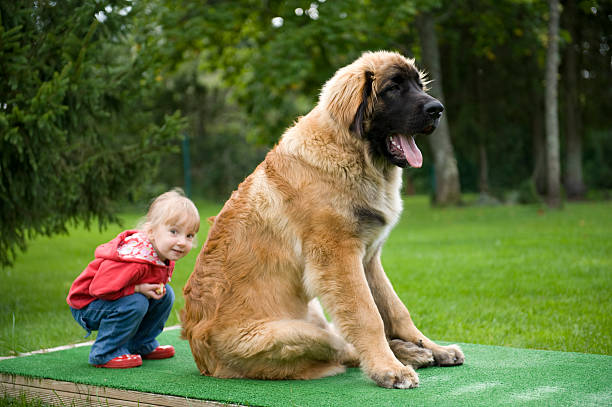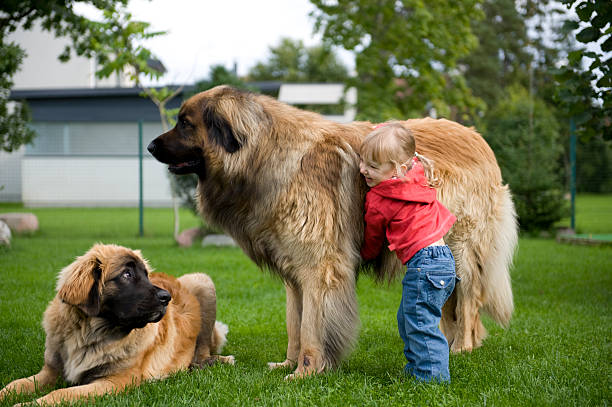Leonberger

Breed History:
The Leonberger originated in the mid-1800s in Leonberg, Germany, where breeder Heinrich Essig aimed to create a majestic dog resembling a lion, the symbol of the town. He achieved this by crossing Newfoundlands, Saint Bernards, and Great Pyrenees, producing a large, noble dog with strength, loyalty, and a striking golden mane.
Originally used as guard dogs, draft animals, and companions for European nobility, Leonbergers became known for their calm demeanour and versatility. Although their population nearly vanished during World War I and World War II, dedicated breed enthusiasts revived it. Today, the Leonberger is valued as a family companion, therapy dog, and working breed, especially in water rescue and cart pulling.
|
Gender |
Height |
Weight |
|
Male |
72-80 cm |
54-77 kg |
|
Female |
65-75 cm |
45-61 kg |
Size – Giant
Life Expectancy: 8–10 years

Breed Appearance:
The Leonberger is a giant, muscular, and well-balanced dog with a majestic lion-like appearance. It has a broad head, dark expressive eyes, and a distinct black mask. The breed’s double coat is long, water-resistant, and ranges from golden to reddish-brown, often with black tips and a lion-like mane, particularly in males.
Its ears are medium-sized and pendant, and its tail is long and bushy, carried low. Despite its massive size, the Leonberger moves with graceful, ground-covering strides, exuding both power and elegance.
Breed Type – Companion/Guardian/Working:
Originally bred for companionship and guarding, the Leonberger excels as a family dog. It is known for being gentle, calm, and affectionate, especially with children. The breed’s even temperament and emotional sensitivity make it particularly suited for therapy work.
While protective of its home, the Leonberger is typically not aggressive and greets strangers with a dignified reserve. Its gentle disposition, patience, and loyalty make it one of the best gentle giants among dog breeds.

Training:
Leonbergers are intelligent and eager to please, making them responsive to training. However, they mature slowly and can be easily overwhelmed by harsh methods. Training should begin early, using positive reinforcement and a calm, patient approach.
Puppy classes, early socialisation, and consistent routines help this breed develop into a well-mannered adult. Despite their size, Leonbergers are sensitive and thrive when training includes encouragement and emotional engagement.
Health & Care:
As a giant breed, the Leonberger is prone to several health issues, including:
-
Hip and elbow dysplasia
-
Gastric torsion (bloat)
-
Osteosarcoma (bone cancer)
-
Polyneuropathy (a neurological disorder)
-
Eye problems (entropion, ectropion, cataracts)
Reputable breeders screen for genetic conditions. Owners should be aware of the shorter lifespan common in giant breeds. A balanced, joint-supportive diet, regular veterinary care, and weight management are essential for long-term health.

Living Conditions:
Leonbergers require space to move and are best suited for homes with large yards. While they can adapt to indoor living, they need frequent outdoor activity and should not be confined for long periods. Due to their thick coat, they prefer cooler climates and may struggle in hot, humid weather.
This breed needs close contact with its family and does not do well in isolation. Without companionship and purpose, it may develop behavioural problems or separation anxiety.
Exercise:
Despite their size, Leonbergers are moderately active and require 60–90 minutes of daily exercise. Walks, swimming, cart pulling, and structured play sessions are ideal. They particularly enjoy water and have natural swimming instincts, making them great for water rescue training.
Puppies and young adults should avoid excessive high-impact activity to prevent joint damage. Mental enrichment through obedience, puzzle toys, or scent work helps prevent boredom.
Grooming:
The Leonberger’s luxurious coat requires regular grooming to stay clean and healthy. Brushing 2–3 times a week helps prevent matting and controls shedding, though more frequent grooming is needed during seasonal sheds.
They are relatively clean dogs with little odour. Occasional bathing, nail trimming, ear cleaning, and dental care are part of routine maintenance. Pay special attention to the feathered areas and dense mane, where tangles may form.

Advantages:
-
Calm, affectionate, and family-friendly temperament
-
Excellent with children and other pets
-
Intelligent and trainable with gentle methods
-
Striking lion-like appearance
-
Naturally protective but not aggressive
-
Versatile: excels in therapy, rescue, and draft work
Disadvantages:
-
A shorter lifespan is typical of giant breeds
-
Prone to joint and digestive health issues
-
Requires ample space and regular exercise
-
Heavy seasonal shedding and grooming needs
-
Can suffer from separation anxiety if left alone
-
Not ideal for hot climates due to the thick coat

